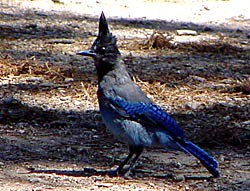|
Common Name (preferred): Steller's Jay Scientific Name: Cyanocitta stelleri Size (weight, length & wingspan) English & Metric: Weight—3.7oz (105g), Length—11.5" (29 cm), Wingspan—19" (47.5 cm) Habitat: Pine-oak woodlands and coniferous forests Diet: Seeds, insects, carrion, eggs, baby birds, & young rodents Predators: Raptors (owls and hawks) 
NPS General Biology: The Steller's Jay ranges west of the Rockies from Alaska to Mexico. Often found in higher elevations of pine-oak woodlands and coniferous forests, they will occasionally drop to lower elevations during the winter. Behavior: 
NPS Jays are omnivorous but feed mainly on seeds, nuts, fruits, and insects. However, they will also kill nestlings and scavenge. Steller's Jays can be easily found in picnic areas begging for food. A Steller's Jay will often announce its arrival with a loud, clamorous call. The Rocky Mountain subspecies is also famous for flaring its white eyebrows when behaving aggressively. They are very good at imitating other birds, especially Red-tailed and Red-shouldered Hawks, flickers, squirrels, and cats. All jays mob predators. Owls and hawks can sometimes be found by following agitated jays and crows. Conservation: 
NPS When and where to see at Bryce: Further Reading: Erlich, Paul R. et al. 1988. The Birder's Handbook: a field guide to the natural history of North American Birds, Simon and Schuster/Fireside Books, New York Ryser, Fred A. 1985. Birds of the Great Basin: A Natural History. University of Nevada Press Sibley, David Allen. 2001. The Sibley Guide to Bird Life and Behavior. Knopf Publishing |
Last updated: June 1, 2022
